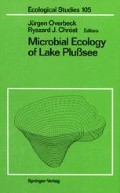Abstract
Until recently it was thought that heterotrophic bacteria in aquatic ecosystems played only a trivial role in organic fluxes and in the functioning of the ecosystem. It was commonly accepted that phytoplankton primary production was utilized predominantly by herbivores (mainly zooplankton) and passed on to the organisms that comprise the grazing food chain. Even in recently published, widely distributed books on limnology, bacteria are still treated as only remineralizers and/or decomposers of organic matter in the energy and organic matter fluxes throughout a lake ecosystem (Wetzel 1983, Cole 1988, Schwoerbel 1987, Sommer 1989, Lampert and Sommer 1993). Very little attention has been directed to further implications of bacterial dynamics for the trophic relationships between these microorganisms and higher trophic levels and the functioning of the lake ecosystem. This notion has changed significantly during the last decade with results from new methods of measuring bacterial production, biomass and activity of bacteria, and their in situ growth rates. In an ecosystem context, these new findings portray bacteria as a very dynamic metabolic and trophic component representing a major pathway for organic matter and energy flux in the aquatic food web (Sherr and Sherr 1988, Ducklow and Carlson 1992, Simon et al. 1992, Chróst 1992).
Access this chapter
Tax calculation will be finalised at checkout
Purchases are for personal use only
Preview
Unable to display preview. Download preview PDF.
References
Azam F, Cho BC (1987) Bacterial utilization of organic matter in the sea. In Fletcher M, Gray TRG, Jones JG (eds) Ecology of Microbial Communities. Cambridge University Press, Cambridge, pp 261–281
Azam F, Hodson RR (1981) Multiphasic kinetics for D-glucose uptake by assemblages of natural marine bacteria. Mar Ecol Prog Ser 6:213–222
Blobel G, Walter P, Chang CN, Goldman BM, Erickson AH, Lingappa VR (1979) Translation of proteins across membranes: The signal hypothesis and beyond. Symp Soc Exp Biol 33:9–36
Bratbak G, Heldal M, Thingstad TF, Riemann B, Haslund OH (1992) Incorporation of viruses into the budget of microbial C-transfer. A first approach. Mar Ecol Prog Ser 83:273–280
Chróst RJ (1990) Microbial ectoenzymes in aquatic environments. In Overbeck J, Chróst RJ (eds) Aquatic Microbial Ecology. Biochemical and Molecular Approaches. Springer-Verlag, New York, pp 47–78
Chróst RJ (1991a) Environmental control of the synthesis and activity of aquatic microbial ectoenzymes. In Chróst RJ (ed) Microbial Enzymes in Aquatic Environments. Springer-Verlag, New York, pp 29–59
Chróst RJ (ed) (1991b) Microbial Enzymes in Aquatic Environments. Springer-Verlag, New York
Chróst RJ (1992) Significance of bacterial ectoenzymes in aquatic environments. Hydrobiologia 243/244:61–70
Chróst RJ, Rai H (1993) Ectoenzyme activity and bacterial secondary production in nutrient-impoverished and nutrient-enriched freshwater mesocosms. Microb Ecol 25:131–150
Cole GA (1988) Textbook of Limnology. Waveland Press, Prospect Heights, Illinois
Dawes EA (1976) Endogenous metabolism and the survival of starved prokaryotes. In Gray TRG, Postgate JR (eds) The Survival of Vegetative Microbes. Cambridge University Press, Cambridge, pp 19–53
Ducklow HW, Carlson CA (1992) Oceanic bacterial production. Adv Microb Ecol 12:113–181
Gomes SL, Shapiro L (1984) Differential expression and positioning of Chemotaxis meth-ylation proteins in Caulobacter. J Mol Biol 178:551–568
Harder W, Dijkhuizen L (1983) Physiological responses to nutrient limitation. Annu Rev Microbiol 37:1–23
Hecker M, Babel W (eds) (1988) Physiologie der Mikroorganismen. Gustav Fischer Verlag, Jena
Höfle MG (1992) Bacterioplankton community structure and dynamics after large-scale release of nonindigenous bacteria as revealed by low-molecular-weight-RNA analysis. Appi Environ Microbiol 58:3387–3394
Jannasch HW (1974) Steady-state and the chemostats in ecology. Limnol Oceanogr 19:716–720
Koch AL (1979) Microbial growth in low concentrations of nutrients. In Shilo M (ed) Strategies of Microbial Life in Extreme Environments. Verlag Chemie, Weinheim, pp 341–356
Konnings WN, Veldkamp H (1983) Energy transduction and solute transport mechanisms in relation to environment occupied by micro-organisms. In Slater JH, Whittenbury R, Wimpenny JWT (eds) Microbes in Their Natural Environments. Cambridge University Press, Cambridge, pp 153–186
Lampert W, Sommer U (1993) Limnoökologie. Georg Thieme Verlag, Stuttgart
Morgan P, Dow CS (1986) Bacterial adaptations for growth in low nutrient environments. In Herbert RA, Codd GA (eds) Microbes in Extreme Environments. Academic Press, London, pp 187–214
Morita RY (1982) Starvation-survival of heterotrophs in the marine environment. Adv Microb Ecol 6:171–198
Neijssel OM, Hueting S, Crabbendam KJ, Tempest DW (1975) Dual pathways of glycerol assimilation in Klebsiella aerogenes NCIB 418. Their role and possible functional significance. Arch Microbiol 104:83–87
Overbeck J, Chróst RJ (eds) (1990) Aquatic Microbial Ecology. Biochemical and Molecular Approaches. Springer-Verlag, New York
Overbeck J, Sako Y (1989) Ecological aspects of enzyme regulation in aquatic bacteria. In Proceedings ISME-5, Japan Scientific Societies Press, Kyoto, pp 378–382
Overbeck J, Rheimheimer G, Gunkel W, Krumbein WE, Weyland H (1991) Stand und Perspektiven der Gewässermikrobiologie in der Bundesrepublik Deutschland. Naturwissenschaften 78:543–556
Pardee AB (1968) Membrane transport proteins. Science 162:632–637
Rosen BP (1971) Basic amino-acid transport in Escherichia coli. J Biol Chem 246:3653–3662
Schwoerbel J (1987) Handbook of Limnology. Ellis Horwood, New York
Sherr BF, Sherr EB (1988) Role of microbes in pelagic food webs: A revised concept. Limnol Oceanogr 33:1225–1227
Simon M, Cho BC, Azam F (1992) Significance of bacterial biomass in lakes and the ocean: Comparison to phytoplankton biomass and biogeochemical implications. Mar Ecol Prog Ser 86:103–110
Sommer U (ed) (1989) Plankton Ecology: Succession in Plankton Communities. Springer-Verlag, New York
Verner K, Schatz G (1988) Protein translocation across membranes. Science 241:1307–1313
Wetzel RG (1983) Limnology, 3rd ed. WB Saunders, Philadelphia
Zambrano MM, Siegele DA, Almirón M, Tormo A, Kolter R (1993) Microbial competition: Escherichia coli mutants that take over stationary phase cultures. Science 259:1757–1760
Editor information
Editors and Affiliations
Rights and permissions
Copyright information
© 1994 Springer-Verlag New York, Inc.
About this chapter
Cite this chapter
Chróst, R.J., Overbeck, J. (1994). Bacterial Life in the Plußsee: General Remarks on Aquatic Microbial Ecology. In: Overbeck, J., Chróst, R.J. (eds) Microbial Ecology of Lake Plußsee. Ecological Studies, vol 105. Springer, New York, NY. https://doi.org/10.1007/978-1-4612-2606-2_17
Download citation
DOI: https://doi.org/10.1007/978-1-4612-2606-2_17
Publisher Name: Springer, New York, NY
Print ISBN: 978-1-4612-7604-3
Online ISBN: 978-1-4612-2606-2
eBook Packages: Springer Book Archive

